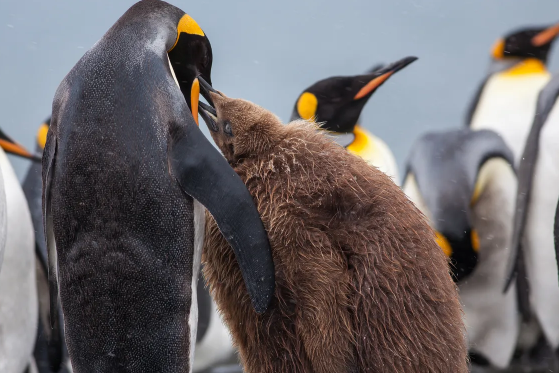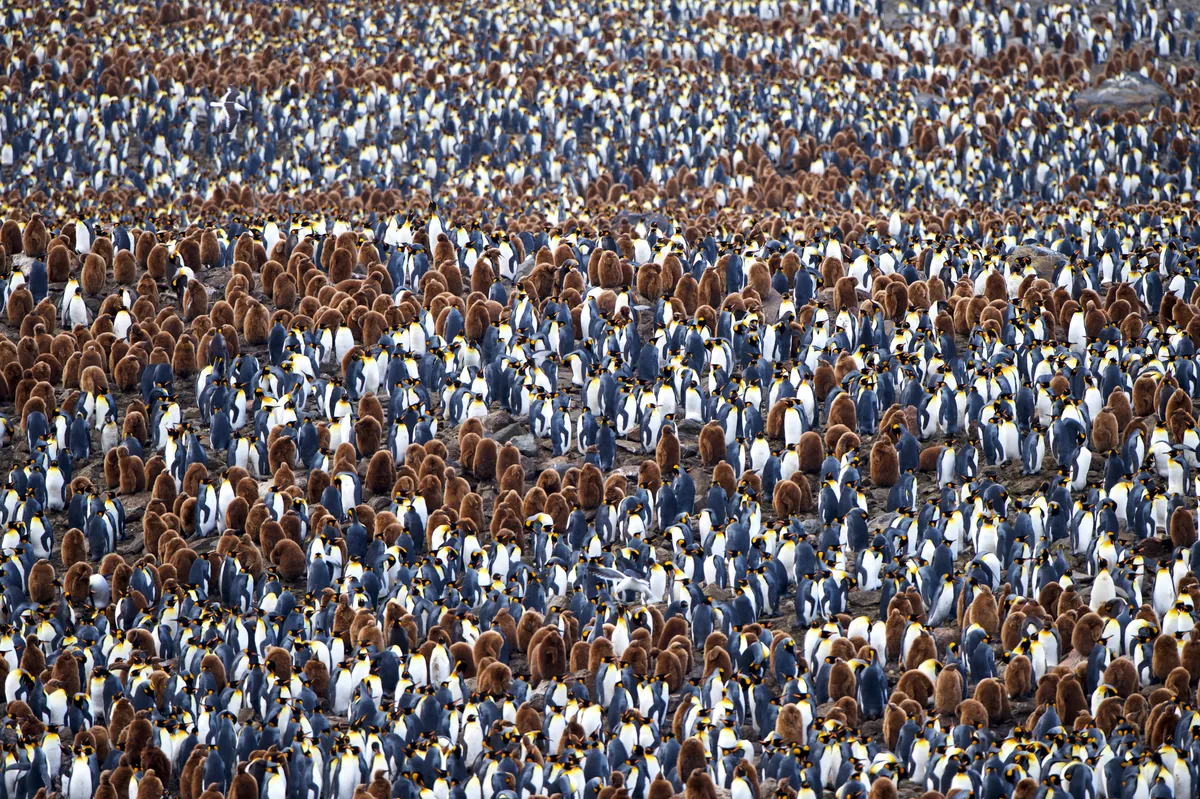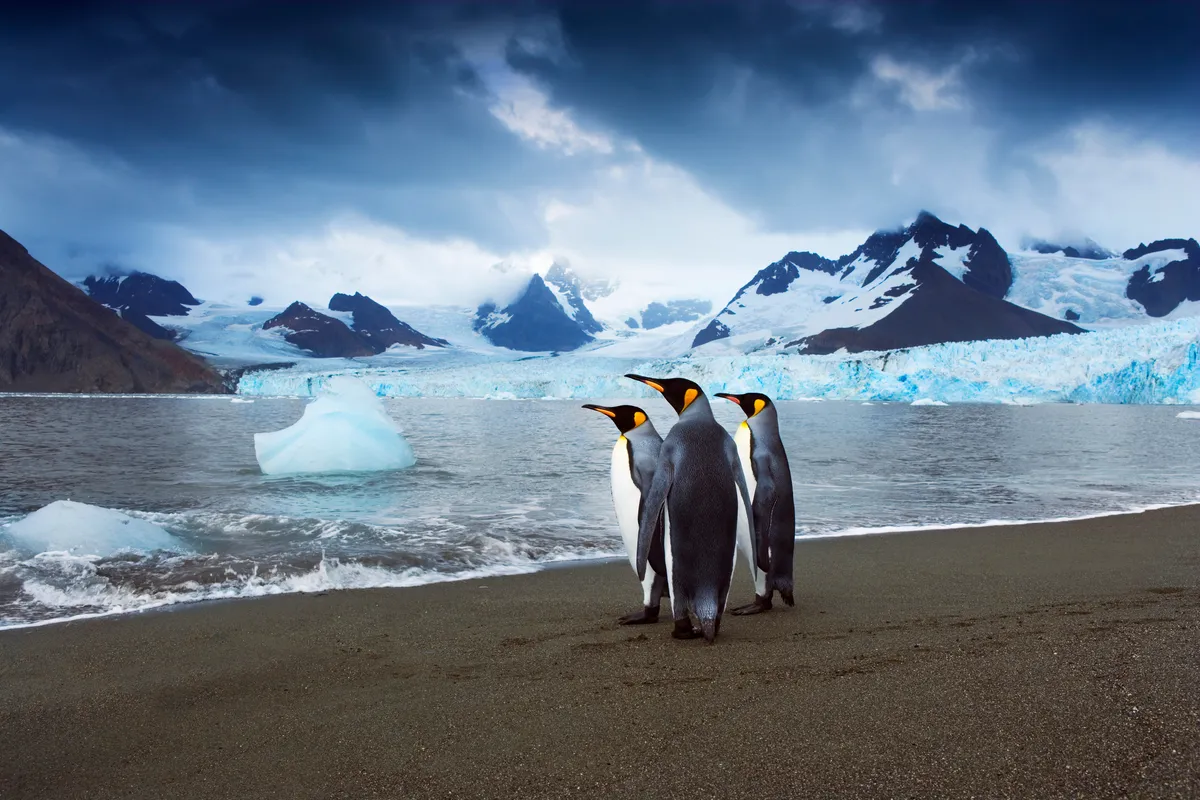
In our expert king penguin guide learn all about this spectacular aquatic flightless bird, including how to identify, their diet and natural habitat.
King penguin, Aptenodytes patagonicus is the second largest species of penguin after the emperor penguin. King penguins are known for forming enormous colonies of up to 100,000 breeding pairs.
The total population of king penguins is about 2.23 million breeding pairs. That’s a lot of penguins! Their population is increasing too, and due to their extremely large range and numbers the IUCN lists them as of Least Concern in terms of extinction risk.
King penguins form vast breeding colonies, for example a colony on South Georgia Island holds over 100,000 breeding pairs.

All is not so rosy however, the colony that was previously the world’s largest, on the French island of Île aux Cochons, has shrunk by almost 90% in the last three decades. This colony once numbered over two million king penguins, now, only 60,000 remain. This decline is thought be be due partly to decreased territory, avian disease, and ‘density dependent effects’ such as increased competition between individuals for food in larger groups. The full story behind this massive colony shrinkage remains a mystery however.
King penguins an be found on most of the subantarctic islands, with the largest colonies now found on Crozet Island (in the southern Indian Ocean), and the islands of Kerguelen, Prince Edward Islands, and South Georgia (a British Overseas Territory in the southern Atlantic).

Fish! And lots of it. Fish makes up about 80% of their diet, and they are particularly partial to small bioluminescent lanternfish. They are however also known to feed on squid and crustaceans. King penguin chicks will eat regurgitated seafood from the mouths of their parents.

King penguins are predated on by orca, leopard seals, fur seals, and South American sea lions. Giant petrels are also known to attack their chicks, and skuas will snatch small chicks and eggs if left unattended.

King penguins also suffer from habitat loss in some parts of their range. In some places this has been due to buildings and road construction encroaching on nesting space, and in others rabbits, an invasive species, have caused erosion triggering landslides onto colonies.
In the future these penguins may also become more and more threatened by the effects of climate change, as global warming restricts and fragments their habitats and they are forced to move elsewhere and travel further distances to forage.
Other threats include occasional entanglement in discarded commercial fishing nets, and oil spill pollution.
It takes teamwork to raise a penguin chick in the frozen climes of the far south. Mike Dilger explains the king penguin’s breeding habits:
The birds are not ready to breed until at least five or six years of age and are serial monogamists – while they remain faithful to their chosen mate for the duration of the breeding season, fidelity from year to year is far less likely.
Kings return to their colonies for a pre-nuptial moult in September or early October, and after a short spell back out at sea to replenish their reserves, they engage in an intense period of courtship that ultimately results in the female producing a single greenish-white egg in November or December.
Like many seabirds in the breeding season, kings adopt a safety-in-numbers strategy, with one of the largest colonies – at St Andrews Bay, South Georgia – numbering a staggering 150,000 pairs.
Lasting between 14 and 16 months, the king’s breeding cycle is one of the longest and most complex of all penguin species.
The parents don’t make nests, but instead balance their egg on top of their feet, enveloping it in a specially adapted brood pouch – a warm layer of abdominal skin filled with blood vessels.
However, unlike the emperors, where the male is left holding the egg, both sexes alternate incubation duties between extended periods feeding at sea.
Hatching commences from January onwards, and as chicks are initially vulnerable to the extreme cold and from predation by skuas, sheathbills and giant petrels, they are never left unattended. Again, both parents divide their time between feeding expeditions and caring for their young.
With a diet comprising a rich, regurgitated fishy mix, the chick grows so quickly that by March it is ready to join a crèche – a group that huddles together for safety – allowing both mum and dad to simultaneously forage.
By this time the chicks should also be in possession of a fluffy, brown downy coat. They look so different to their parents that the first explorers to breeding colonies thought the youngsters belonged to a different species called ‘woolly penguins’.
Did you know? Family members find one another by means of uniquely weird and wonderful braying calls
Fairly independent by May, the chicks then stay in the colony for the duration of the austral winter and are fed less frequently.
When their parents finally return in the southern spring, all that remains is for the youngsters to moult into their adult feathers before heading into the big blue yonder for their first fishing trip.
With the young departed, this not only completes the loop of this most convoluted breeding cycle, but also gives their hardworking parents a much-needed break from the rigours of chick-rearing.
Hera are the top four places where king penguins breed:
- Falkland Islands Back in 1971, there were just 31 breeding pairs of king penguins breeding at Volunteer Point, on East Falkland Island, but the population has since leapt to around 1,500 pairs.
- Kerguelen Island One of the most remote breeding colonies is found on these French sub-Antarctic islands. The only way to reach them is on a scientific ship sailing from the tropical Réunion Island, near Madagascar.
- Macquarie Island Situated halfway between New Zealand and Antarctica; this island has 150,000 to 170,000 pairs of breeding king penguins.
- South Georgia Recent evaluations indicate the island has the world’s largest breeding population, with 450,000 pairs spread over 30 distinct colonies.
Did you know? As the oceans warm due to climate change, the king penguins’ primary hunting grounds may be forced further south. As the distance between breeding grounds and food increases, entire colonies may be forced to rapidly relocate or could potentially be wiped out altogether.
The most famous king penguin is perhaps Brigadier Sir Nils Olav, colonel-in-chief of the Norwegian King’s Guard! The distinguished penguin lives at Edinburgh Zoo, and is the third of their king penguins to be a member of the King’s Guard since the rank of Corporal was bestowed on Nils Olav I in 1982.

This tradition stems from when the Scandinavian country presented the zoo with its first ever king penguin at its opening in 1913. When the Norwegian King’s Guard visited the Edinburgh Military Tattoo for a drill display in 1961, a lieutenant called Nils Egelien became interested in the zoo’s penguin colony, and in 1972 arranged for the regiment to adopt a penguin. This penguin’s successor was awarded a knighthood in 2008, which was approved by the Norwegian King, and in 2016 the current Sir Nils was promoted to the rank of brigadier.

Main image: A group of king penguins. © Mint Images – David Schultz/Getty
Find out more about these lovely creatures with our expert guides, from a comprehensive penguin guide to answers to questions like how deep do penguins dive and why are there no penguins in the artic.










